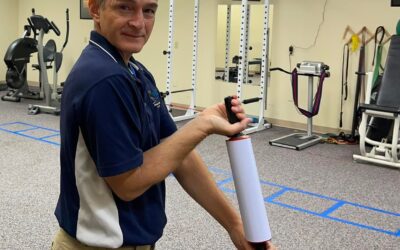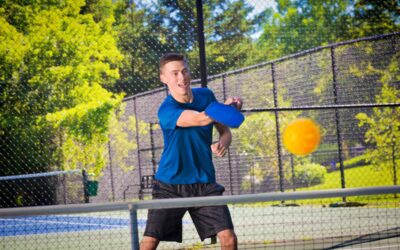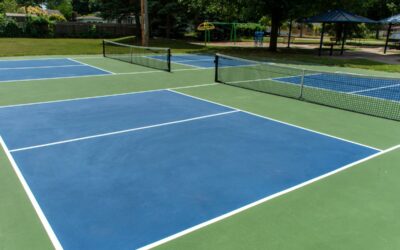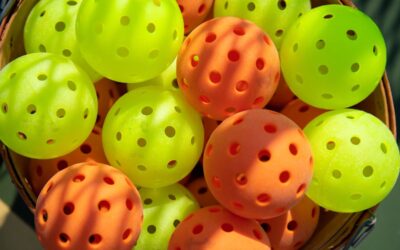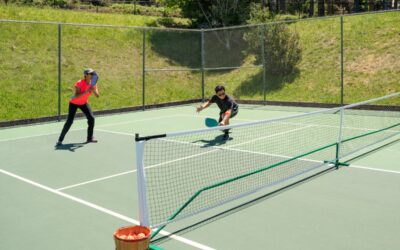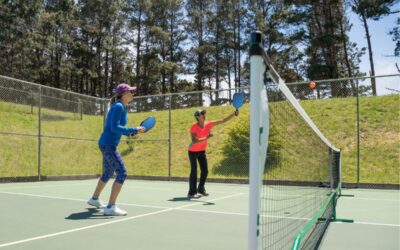Pickleball Safety for Seniors
Whether you are in your 40’s, 60’s, or 80+, pickleball safety is a top priority when you are a recreational pickleball player.
I am 47 years old and the last thing I need is to get hurt while playing pickleball. Silly injuries not only take me out of the game, but they also make the rest of my life more challenging.
As a physical therapist, I see pickleball injuries in my clinic all the time. Here is a list of my top 10 tips for staying safe while playing pickleball as an adult in 2022.
1. Stay Hydrated
Pickleball is often played outdoors and in many warm climates staying properly hydrated can be a real challenge. I recently published an article about getting muscle cramps in pickleball and a big part of that article discussed hydration.
The best clinical guidelines on staying hydrated while playing any recreational activity in warm weather suggest monitoring body weight and drinking enough fluids to maintain body weight.
For example, a 150-lbs adult might lose 2 lbs of body weight playing a competitive pickleball game in 87-degree weather. This person should consume approximately 24 ounces of fluids during the match or shortly after.
2. Proper Warmup
A proper warmup does not always mean stretching. Warming up your body for peak physical performance includes increasing the actual temperature of your body, increasing the neurological activity within your nervous system, and making sure all of your body’s muscles and joints are able to move through a full range of motion.
Body Temperature
Just as warming up your car on a cold winter morning, warming up the body with light cardiovascular activity can help improve synovial fluid viscosity and joint lubrication.
Gentle jogging, jumping jacks, or other low-impact and low-intensity exercise for 2 to 5 minutes will elevate the temperature of your joints and muscles while priming your body for movement.
Nervous System
Muscle performance, balance, and coordination are controlled largely by the body’s central nervous system. Intentional movements and reflexive reactions may benefit from “waking up” the body’s nervous system.
After increasing your body’s temperature and heart rate, some plyometric jumps or sprints might be a great way to excite the nervous system and get it ready for action.
Range of Motion
Finally, the last part of any comprehensive warmup includes a range of motion exercises. This is slightly different from static stretching.
Range of motion exercises for pickleball includes moving all the major joints of the body through a complete range of motion.
Trunk twists, shoulder swings, and hip circles are a couple of the most common range of motion warmup activities.
3. Check the Environment
A clean and well-lighted court is important. I have seen players playing on courts with leaves or other debris. Be sure your pickleball court’s playing surface is clean, dry, and well-lighted.
Look for cracks, sand, or gravel that might cause you to slide or trip.
If you will be playing later in the evening be sure to prepare for sunset and dim lighting.
4. Well Matched Opponents
Everyone loves a challenge, but be sure you aren’t playing too far above or below your ability level.
I often see players hoping to improve their game playing far better opponents. It can be great to play up, but keep in mind that you will improve your skills and ability in training and during practice, not in a competitive match.
Use competitive gameplay to assess your progress, but choose a competition level that is well matched to your current abilities.
5. Cool Down
Just as a proper warmup is a major part of pickleball safety, a proper cool-down is just as important.
I like to teach my pickleball athletes to use the time after a match to perform the static stretches not done during the warmup.
Using tools like a foam roll or massage gun is also a great option to incorporate during your cool down.
If the match was really intense, I often recommend a light-intensity jog or pedaling a stationary bike for 5 to 10 minutes as a way to pump blood back out of the legs and into the system.
6. Strength Training
No pickleball safety program should omit a comprehensive strength training program. While the sport of pickleball requires quickness, agility, timing, and coordination, it also requires strength.
Having adequate strength to move your body through space and control the rapid acceleration/deceleration of your arms and legs are required to reduce your chances of injury.
A whole-body strengthening program may be performed with simple bodyweight exercises or resistance training. Many pickleball players will carry elastic bands in their equipment bag, but making time for a structured resistance program could reduce pickleball safety as well as improve pickleball performance.
7. Power Training
Strength and power are not the same things.
Strength is the body’s ability to generate force.
Power is the body’s ability to generate force quickly.
A pickleball and pickleball paddle is light and requires more power than strength. Some examples of power exercises might include swinging a lightweight large face paddle against wind resistance. Other power exercises include plyometric training.
Bonus Tip
Pickleball safety should also include a physical therapy evaluation.
Of course, I am biased toward finding and working with a great physical therapist, but I believe the best way to stay safe playing pickleball is to connect with a physical therapist who understands the game of pickleball and who can perform a comprehensive orthopedic examination on you.
This examination and evaluation will help you identify potential weaknesses and possible injury risks. Your physical therapist will also help create a treatment plan to minimize injury risk while optimizing for performance.
For more safety tips watch Coach Simone’s video Safety for Beginners

Anthony Maritato, PT
Physical Therapist / Author
Hi! My name is Anthony Maritato, PT but please call me Tony. I have been a licensed physical therapist since 2006 and a strength and conditioning coach since 2000.
I am new to the sport of pickleball, but I have been working with pickleball athletes for most of my physical therapy career. To learn more about my physical therapy clinic visit Total Therapy Solutions.
More Related Articles
5 Best Pickleball Hand and Wrist Exercises
Pickleball Hand and Wrist Exercises Forearm Supination and Pronation Wrist Flexion and Extension Wrist Ulnar and Radial Deviation Finger Flexion and Extension Gripping 1. Forearm Supination and Pronation Supination is the act of turning your palm up so that it is...
How To Play Pickleball Singles
Pickleball is a paddle sport that incorporates elements of tennis, badminton, and ping-pong. It was created on Bainbridge Island, Washington, US, in 1965. Pickleball’s popularity has grown around the world, but in the Pacific Northwest in particular - so much so that...
What Does A Pickleball Court Look Like?
Just like any sport, there are official dimensions and measurements for a pickleball court. The size of a pickleball court will be 20 by 44 feet, effectively the same size you would see in a doubles badminton court. Yet for pickleball, the court remains the same size...
What Does A Pickleball Look Like?
Pickleball is a lot like tennis, and is also similar to ping pong (table tennis) too, however, you can’t use a tennis ball or a ping pong ball to play this game. Pickleball has its own ball that is used to play it. A majority of net based games will have balls that...
How Does A Round Robin Tournament Work?
Pickleball is a very popular sport that combines the best elements of tennis, ping-pong, and even badminton into one easy-to-follow activity. The game has seen a huge rise in popularity in recent years, and it is easy to see why; pickleball is a game that is fun to...
What Is A Drop Shot In Pickleball?
Pickleball features a variety of different techniques and unique shots, however, there aren’t many that are as crucial as the drop shot. This move is renowned for being pretty tough to learn. However, it is especially crucial whenever the level of play is enhanced....
